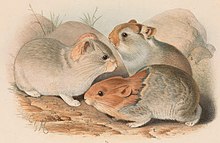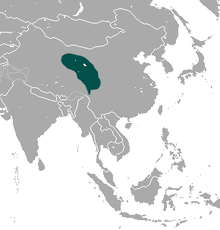Chinese red pika: Difference between revisions
m r2.5.1) (robot Adding: ru:Китайская пищуха |
Citation bot (talk | contribs) Altered url. URLs might have been anonymized. | Use this bot. Report bugs. | Suggested by AManWithNoPlan | #UCB_toolbar |
||
| (45 intermediate revisions by 34 users not shown) | |||
| Line 1: | Line 1: | ||
{{Short description|Species of mammal}} |
|||
<!-- This article was auto-generated by [[User:Polbot]]. --> |
|||
{{Use dmy dates|date=March 2017}} |
|||
{{Taxobox |
|||
{{speciesbox |
|||
| name = Chinese |
| name = Chinese red pika |
||
| image = |
|||
| ⚫ | |||
| status = LC | status_system = IUCN3.1 |
| status = LC | status_system = IUCN3.1 |
||
| status_ref = <ref name=iucn>{{ |
| status_ref = <ref name="iucn status 15 November 2021">{{cite iucn |author=Smith, A.T. |author2=Lissovsky, A. |date=2016 |title=''Ochotona erythrotis'' |volume=2016 |page=e.T41260A45183115 |doi=10.2305/IUCN.UK.2016-3.RLTS.T41260A45183115.en |access-date=15 November 2021}}</ref> |
||
| |
| genus = Ochotona |
||
| |
| species = erythrotis |
||
| authority = ([[species:Eugen Büchner|Büchner]], 1890) |
|||
| classis = [[Mammalia]] |
|||
| ⚫ | |||
| ordo = [[Lagomorpha]] |
|||
| familia = [[Ochotonidae]] |
|||
| genus = ''[[Ochotona]]'' |
|||
| species = '''''O. erythrotis''''' |
|||
| ⚫ | |||
| binomial_authority = (Büchner, 1890) |
|||
| ⚫ | |||
| range_map = Chinese Red Pika area.png |
| range_map = Chinese Red Pika area.png |
||
| range_map_caption = Chinese |
| range_map_caption = Chinese red pika range |
||
}} |
}} |
||
The '''Chinese Red Pika''' ('''''Ochotona erythrotis''''') is a species of [[mammal]] in the [[Ochotonidae]] family. It is [[Endemism|endemic]] to [[China]]. |
|||
The '''Chinese red pika''' ('''''Ochotona erythrotis''''') is a species of [[mammal]] in the family [[Ochotonidae]]. Typical of a [[pika]] it has short limbs, a small tail and round ears. Specific to the Chinese red pika has distinctive red color in its pelt.<ref>Chapman, J.A., Flux, J.C.E. 1990, "Rabbits, Hares and Pikas:Status Survey and Conservation Action Plan. IUCN, Gland, Switzerland</ref> The Chinese pika typically lives in rocky terrain at altitudes between 600 and 1200 meters.<ref name="ReferenceA">Smith, Andrew T. "Pika". Encyclopædia Britannica. Retrieved 2013-08-15</ref> and is [[endemic]] to the East Qinghai, West Gansu and Northern Sichuan [[Provinces of the People's Republic of China|provinces]] of [[China]] and Eastern [[Tibet]].<ref name="Mammal Species of the World">{{MSW3 Lagomorpha | id = 13500025 | pages = 187-188}}</ref> |
|||
==Description== |
|||
The Chinese red pika is one of the largest [[pika]] species,<ref name="wildpro.twycrosszoo.org">Ochotona erythrotis – Chinese Red pika. “[http://wildpro.twycrosszoo.org/S/0MLagomorph/Ochotonidae/Ochotona/Ochotona_erythrotis.htm Wildpro – The Electronic Encyclopaedia and Library for Wildlife.] {{Webarchive|url=https://web.archive.org/web/20190525164456/http://wildpro.twycrosszoo.org/S/0MLagomorph/Ochotonidae/Ochotona/Ochotona_erythrotis.htm |date=25 May 2019 }}”</ref> averaging a length of 18 to 29 cm.<ref name="iucn status 15 November 2021" /> This pika has both a winter and summer pelt. The winter pelt is thicker for the cooler weather, and is a grey color with a slight tint of red in the ear region. In the summer, this species has a coat that is a rusty-red color at the head and chest and progressively becomes more grey at the tail end of the animal. The stomach region of ''O. erythrotis'' is a white color in both pelts.<ref name="wildpro.twycrosszoo.org"/> |
|||
==Speciation== |
|||
The Chinese red pika was formerly regarded as a subgenus of Pika, included first with [[Glover's pika|''Ochotona gloveri'']] and later with [[Turkestan red pika|''Ochotona rutila'']] until they were determined to be separate species (mammal species). The pika species ''O. gloveri'' is believed to be the closest relative to ''O. erythrotis''. The two species are considered to have an [[allopatric]] relationship.<ref name="wildpro.twycrosszoo.org"/> |
|||
Differences between ''O. erythrotis'', ''O. gloveri'', and ''O. rutila'' are primarily seen in the shape of the skull and in fur color. The Chinese Red Pika has larger auditory bullae, a shorter nasals cavity, and a broader rostrum than ''O. gloveri''.<ref name="wildpro.twycrosszoo.org"/> It has a smaller, and more arched skull than ''O. rutila'' and additionally has frontal fenestrae.<ref name="wildpro.twycrosszoo.org"/> Additionally, these subspecies have different fur colorations. ''O. gloveri'' has darker fur than ''O. erythrotis''. Its summer fur is darker with more of a brown tint with a distinct rusty red color on the nose, forehead and ear region. In the winter, its coat is much lighter than ''O. erythrotis''.<ref>{{cite journal |last1=Yu |first1=Ning |last2=Zheng |first2=Changlin |last3=Shi |first3=Liming |title=Variation in mitochondrial DNA and phylogeny of six species of pikas (''Ochotona'') |journal=Journal of Mammalogy |date=1997 |volume=78 |issue=2 |pages=387–396 |doi=10.2307/1382892 |url=https://www.jstor.org/stable/1382892 |jstor=1382892 }}</ref> |
|||
==Reproduction== |
|||
''O. erythrotis'' have an average of two litters per year, usually averaging 3–7 young per litter.<ref name="iucn status 15 November 2021" /> Their reproductive season is between May and August.<ref name="iucn status 15 November 2021" /> |
|||
==Geography== |
|||
''O. erythrotis'' is found in China and East Tibet. Specifically in China, ''O. erythrotis'' can be found in East Qinghai, West Gansu and Northern Sichuan.<ref name="Mammal Species of the World"/> |
|||
==Habitat== |
|||
The Chinese red pika is primarily a rock-dwelling pika. It can be found in cliff and rock terrain <ref name="wildpro.twycrosszoo.org"/> or in the alpine shrubland and meadows near rock formations<ref name="iucn status 15 November 2021" /> primarily at an altitude of {{convert|600|–|1200|m}}.<ref name="ReferenceA"/> This species has been observed to be adaptable and opportunistic in where it lives. This pika species is a burrowing species, which makes burrows that are 1–2 meters in length.<ref name="wildpro.twycrosszoo.org"/> |
|||
==References== |
==References== |
||
{{Reflist}} |
{{Reflist|2}} |
||
{{Lagomorpha|O.}} |
{{Lagomorpha|O.}} |
||
{{Taxonbar|from=Q311593}} |
|||
| ⚫ | |||
[[Category:Pikas]] |
[[Category:Pikas]] |
||
| ⚫ | |||
[[Category:Endemic fauna of China]] |
|||
{{Lagomorph-stub}} |
|||
[[Category:Mammals described in 1890]] |
|||
[[Category:Taxa named by Eugen Büchner]] |
|||
[[br:Pika ruz Sina]] |
|||
[[Category:Taxonomy articles created by Polbot]] |
|||
[[ca:Pica vermella de la Xina]] |
|||
[[es:Ochotona erythrotis]] |
|||
[[fa:پیکای سرخ چینی]] |
|||
[[fr:Ochotona erythrotis]] |
|||
[[it:Ochotona erythrotis]] |
|||
[[pt:Ochotona erythrotis]] |
|||
[[ru:Китайская пищуха]] |
|||
[[zh:红耳 |
|||
Latest revision as of 21:31, 28 February 2024
| Chinese red pika | |
|---|---|

| |
| Scientific classification | |
| Domain: | Eukaryota |
| Kingdom: | Animalia |
| Phylum: | Chordata |
| Class: | Mammalia |
| Order: | Lagomorpha |
| Family: | Ochotonidae |
| Genus: | Ochotona |
| Species: | O. erythrotis
|
| Binomial name | |
| Ochotona erythrotis (Büchner, 1890)
| |

| |
| Chinese red pika range | |
The Chinese red pika (Ochotona erythrotis) is a species of mammal in the family Ochotonidae. Typical of a pika it has short limbs, a small tail and round ears. Specific to the Chinese red pika has distinctive red color in its pelt.[2] The Chinese pika typically lives in rocky terrain at altitudes between 600 and 1200 meters.[3] and is endemic to the East Qinghai, West Gansu and Northern Sichuan provinces of China and Eastern Tibet.[4]
Description[edit]
The Chinese red pika is one of the largest pika species,[5] averaging a length of 18 to 29 cm.[1] This pika has both a winter and summer pelt. The winter pelt is thicker for the cooler weather, and is a grey color with a slight tint of red in the ear region. In the summer, this species has a coat that is a rusty-red color at the head and chest and progressively becomes more grey at the tail end of the animal. The stomach region of O. erythrotis is a white color in both pelts.[5]
Speciation[edit]
The Chinese red pika was formerly regarded as a subgenus of Pika, included first with Ochotona gloveri and later with Ochotona rutila until they were determined to be separate species (mammal species). The pika species O. gloveri is believed to be the closest relative to O. erythrotis. The two species are considered to have an allopatric relationship.[5] Differences between O. erythrotis, O. gloveri, and O. rutila are primarily seen in the shape of the skull and in fur color. The Chinese Red Pika has larger auditory bullae, a shorter nasals cavity, and a broader rostrum than O. gloveri.[5] It has a smaller, and more arched skull than O. rutila and additionally has frontal fenestrae.[5] Additionally, these subspecies have different fur colorations. O. gloveri has darker fur than O. erythrotis. Its summer fur is darker with more of a brown tint with a distinct rusty red color on the nose, forehead and ear region. In the winter, its coat is much lighter than O. erythrotis.[6]
Reproduction[edit]
O. erythrotis have an average of two litters per year, usually averaging 3–7 young per litter.[1] Their reproductive season is between May and August.[1]
Geography[edit]
O. erythrotis is found in China and East Tibet. Specifically in China, O. erythrotis can be found in East Qinghai, West Gansu and Northern Sichuan.[4]
Habitat[edit]
The Chinese red pika is primarily a rock-dwelling pika. It can be found in cliff and rock terrain [5] or in the alpine shrubland and meadows near rock formations[1] primarily at an altitude of 600–1,200 metres (2,000–3,900 ft).[3] This species has been observed to be adaptable and opportunistic in where it lives. This pika species is a burrowing species, which makes burrows that are 1–2 meters in length.[5]
References[edit]
- ^ a b c d e Smith, A.T.; Lissovsky, A. (2016). "Ochotona erythrotis". IUCN Red List of Threatened Species. 2016: e.T41260A45183115. doi:10.2305/IUCN.UK.2016-3.RLTS.T41260A45183115.en. Retrieved 15 November 2021.
- ^ Chapman, J.A., Flux, J.C.E. 1990, "Rabbits, Hares and Pikas:Status Survey and Conservation Action Plan. IUCN, Gland, Switzerland
- ^ a b Smith, Andrew T. "Pika". Encyclopædia Britannica. Retrieved 2013-08-15
- ^ a b Hoffman, R.S.; Smith, A.T. (2005). "Order Lagomorpha". In Wilson, D.E.; Reeder, D.M (eds.). Mammal Species of the World: A Taxonomic and Geographic Reference (3rd ed.). Johns Hopkins University Press. pp. 187–188. ISBN 978-0-8018-8221-0. OCLC 62265494.
- ^ a b c d e f g Ochotona erythrotis – Chinese Red pika. “Wildpro – The Electronic Encyclopaedia and Library for Wildlife. Archived 25 May 2019 at the Wayback Machine”
- ^ Yu, Ning; Zheng, Changlin; Shi, Liming (1997). "Variation in mitochondrial DNA and phylogeny of six species of pikas (Ochotona)". Journal of Mammalogy. 78 (2): 387–396. doi:10.2307/1382892. JSTOR 1382892.

